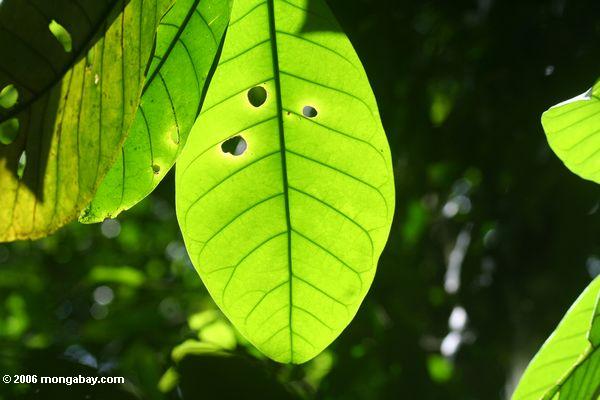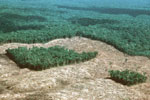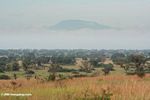Small climate shifts having unexpectedly large changes in tropical rainforests
Slight rises in temperatures are triggering rainforest trees to produce more flowers, reports a new study published in the journal Nature Climate Change.
The research is based on observations collected in two tropical forests: a seasonally dry forest on Panama’s Barro Colorado Island and a “rainforest” with year-around precipitation in Luquillo, Puerto Rico. The authors, led by Stephanie Pau, currently at Florida State University but formerly from UC Santa Barbara, analyzed the impact of changes in temperature, clouds and rainfall on flower production. They found an annual 3 percent increase in flower production at the seasonally dry site, which they attributed to warmer temperatures.
The findings lend support to other research suggesting that tropical forests are seeing significant changes from small climate shifts.
“Tropical forests are commonly thought of as the lungs of the Earth and how many flowers they produce is one vital sign of their health,” said Pau in a statement. “However, there is a point at which forests can get too warm and flower production will decrease. We’re not seeing that yet at the sites we looked at, and whether that happens depends on how much the tropics will continue to warm.”
“With most projections of future climate change, people have emphasized the impact on high-latitude ecosystems because that is where temperatures will increase the most,” Pau continued. “The tropics, which are already warm, probably won’t experience as much of a temperature increase as high-latitude regions. Even so, we’re showing that these tropical forests are still really sensitive to small degrees of change.”

Canopy of the Panamanian rainforest
Other studies have found evidence of increased growth rates in tropical forests, which some have attributed to the fertilization effect from elevated atmospheric carbon dioxide concentrations. For example, a paper published in Geophysical Research Letters in May reporting “greening” in dry regions due to carbon dioxide fertilization. But that research added that rainforests are unlikely to see big increases in bioaccumulation.
“Leaf cover in warm, wet places like tropical rainforests is already about as extensive as it can get and is unlikely to increase with higher CO2 concentrations,” explained a statement from the American Geophysical Union, which publishes Geophysical Research Letters. “In warm, dry places, on the other hand, leaf cover is less complete, so plants there will make more leaves if they have enough water to do so.”

Still other studies, including a 2007 paper published in Ecology Letters by a co-author of the current Nature Climate Change paper, indicate that rising temperatures could eventually lead some tropical forest trees to hit a wall, where growth slows or even reverses due to increased respiration.
“Increases in atmospheric CO2 provide more substrate for photosynthesis and might lead to increased growths,” said Joseph Wright, a scientist at the Smithsonian Tropical Research Institute, in 2007. “Increases in temperature increase respiration rates and might lead to decreased growth, as appears to be the case in our study.”
CITATION: Stephanie Pau, Elizabeth M. Wolkovich, Benjamin I. Cook, Christopher J. Nytch, James Regetz, Jess K. Zimmerman & S. Joseph Wright. Clouds and temperature drive dynamic changes in tropical flower production. Nature Climate Change Letter | 7 July 2013
Related articles
Warming world hits fig wasps and figs

(06/19/2013) Recent experiments concerning hugely-important fig plants (Ficus) and their relationship with small, short-lived fig wasps suggest dire potential consequences due to human induced climate change, finds a study published in the journal Biology Letters. The researchers collected four species of adult female fig wasps from the lowland tropical forests of Singapore to test their tolerance to gradually increased temperatures.
Rainforests will survive extreme global warming, argues study

(06/02/2013) Rainforests in South America have endured three previous extreme global warming events in the past, suggesting they will survive a projected 2-6 degree rise in temperatures over the coming century, reports a study published in the Annual Review of Earth and Planetary Science. The research, published by Carlos Jaramillo and Andrés Cárdenas of the Smithsonian Tropical Research Institute (STRI) in Panama, reviewed some 3,800 published estimates of temperature over the past 120 million years and compared them to the existence of tropical plants in the fossil record.
Rainforests may be more resilient to global warming – in isolation – than previously forecast
(03/11/2013) Tropical forests may be less sensitive to global warming than previously thought, argues a new study published in Nature Geoscience.
Will Amazon species lose the climate change race?

(02/14/2013) Deforestation could increase the risk of biodiversity loss in the Amazon by forcing species to migrate further in order to remain at equilibrium with changing climates, says new research. “As migration models are made more realistic through the inclusion of multiple climatic, biotic, abiotic and human factors, the predicted distances between current and future climate analogues invariably increases,” Kenneth Feeley, lead author of the paper published in Global Change Biology, told mongabay.com.
Forests worldwide near tipping-point from drought

(11/23/2012) Forests worldwide are at ‘equally high risk’ to die-off from drought conditions, warns a new study published this week in the journal Nature. The study, conducted by an international team of scientists, assessed the specific physiological effects of drought on 226 tree species at 81 sites in different biomes around the world. It found that 70 percent of the species sampled are particularly vulnerable to reduction in water availability. With drought conditions increasing around the globe due to climate change and deforestation, the research suggests large swathes of the world’s forests — and the services they afford — may be approaching a tipping point.
Amazon deforestation could trigger drop in rainfall across South America

(09/06/2012) Deforestation could cause rainfall across the Amazon rainforest to drop precipitously, warns a new study published in the journal Nature. Using a computer model that accounts for forest cover and rainfall patterns, Dominick Spracklen of the University of Leeds and colleagues estimate that large-scale deforestation in the Amazon could reduce basin-wide rainfall 12 percent during the wet season and 21 percent in the dry season by 2050. Localized swings would be greater.
Borneo’s forests face dire future from global warming
(07/18/2012) Already wracked by extensive deforestation and forest degradation, the future looks grim for Borneo’s tropical rainforests, reports a new study published in the Journal of Geophysical Research-Biogeosciences.
Scientists slam Telegraph blogger’s claims that climate change will be good for the Amazon
(07/12/2012) Recent blog posts on The Telegraph and the Register claiming that tropical rainforests like the Amazon are set to benefit from climate change are ‘uninformed’ and ‘ridiculous’ according to some of the world’s most eminent tropical forest scientists. The posts, published Sunday and Monday by Tim Worstall, a Senior Fellow at London’s Adam Smith Institute, asserted that a new Nature study indicates that ‘climate change will mean new and larger tropical forests.’ But some of the world’s leading tropical forest experts took aim at Worstall’s logic, noting the limitations of the study as well as the other factors that are endangering rainforests.
Warmer forests expel carbon from soils creating “vicious cycle”

(06/13/2012) As the world warms, temperate forests could become a source of carbon dioxide emission rather than a sink according to a new study in the Proceedings of the National Academy of Sciences (PNAS). Scientists found that two forest sites in the U.S. (Wisconsin and North Carolina) emitted long-stored carbon from their soils when confronted with temperatures 10-20 degrees Fahrenheit (5.5-11.1 degrees Celsius) higher than average.
Cloud forests may be particularly vulnerable to climate change
(03/26/2012) Mexico could lose nearly 70 percent of its cloud forests due to climate change by 2080, according to new research published in Nature Climate Change, that has implications for cloud forests worldwide.
Deforestation, climate change threaten the ecological resilience of the Amazon rainforest
(01/19/2012) The combination of deforestation, forest degradation, and the effects of climate change are weakening the resilience of the Amazon rainforest ecosystem, potentially leading to loss of carbon storage and changes in rainfall patterns and river discharge, finds a comprehensive review published in the journal Nature.
2010 Amazon drought released more carbon than India’s annual emissions
(10/09/2011) The 2010 drought that affected much of the Amazon rainforest triggered the release of nearly 500 million tons of carbon (1.8 billion tons of carbon dioxide) into the atmosphere, or more than the total emissions from deforestation in the region over the period, estimates a new study published in the journal Environmental Research Letters.
Lessons from the world’s longest study of rainforest fragments

(08/15/2011) For over 30 years, hundreds of scientists have scoured eleven forest fragments in the Amazon seeking answers to big questions: how do forest fragments’ species and microclimate differ from their intact relatives? Will rainforest fragments provide a safe haven for imperiled species or are they last stand for the living dead? Should conservation focus on saving forest fragments or is it more important to focus the fight on big tropical landscapes? Are forest fragments capable of regrowth and expansion? Can a forest—once cut-off—heal itself? Such questions are increasingly important as forest fragments—patches of forest that are separated from larger forest landscapes due to expanding agriculture, pasture, or fire—increase worldwide along with the human footprint.
